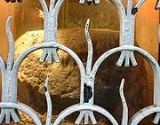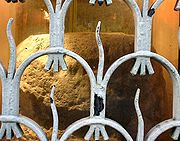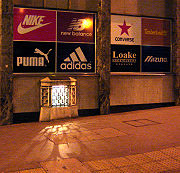
London Stone
Encyclopedia


Rock (geology)
In geology, rock or stone is a naturally occurring solid aggregate of minerals and/or mineraloids.The Earth's outer solid layer, the lithosphere, is made of rock. In general rocks are of three types, namely, igneous, sedimentary, and metamorphic...
that is now set within a Portland stone
Portland stone
Portland stone is a limestone from the Tithonian stage of the Jurassic period quarried on the Isle of Portland, Dorset. The quarries consist of beds of white-grey limestone separated by chert beds. It has been used extensively as a building stone throughout the British Isles, notably in major...
surround and iron grille on Cannon Street
Cannon Street
Cannon Street is a road in the south of the City of London. It runs roughly parallel with the River Thames, and about 250 metres north of it. It is the site of the ancient London Stone.-Etymology:...
, in the City of London
City of London
The City of London is a small area within Greater London, England. It is the historic core of London around which the modern conurbation grew and has held city status since time immemorial. The City’s boundaries have remained almost unchanged since the Middle Ages, and it is now only a tiny part of...
.
Features
The stone is a block of oolitic limestone - a material which does not occur naturally in London - and measures approximately 53x43x30cm. It is thought to have originally been much larger, and have been a RomanRoman Empire
The Roman Empire was the post-Republican period of the ancient Roman civilization, characterised by an autocratic form of government and large territorial holdings in Europe and around the Mediterranean....
milestone
Milestone
A milestone is one of a series of numbered markers placed along a road or boundary at intervals of one mile or occasionally, parts of a mile. They are typically located at the side of the road or in a median. They are alternatively known as mile markers, mileposts or mile posts...
, or possibly a Druid
Druid
A druid was a member of the priestly class in Britain, Ireland, and Gaul, and possibly other parts of Celtic western Europe, during the Iron Age....
ic altar. It is said to be the place from which all distances were measured in Roman Britain
Roman Britain
Roman Britain was the part of the island of Great Britain controlled by the Roman Empire from AD 43 until ca. AD 410.The Romans referred to the imperial province as Britannia, which eventually comprised all of the island of Great Britain south of the fluid frontier with Caledonia...
.
History
The Stone sometimes called the Stone of BrutusBrutus of Troy
Brutus or Brute of Troy is a legendary descendant of the Trojan hero Æneas, known in mediæval British legend as the eponymous founder and first king of Britain...
, referring to legendary Trojan
Troy
Troy was a city, both factual and legendary, located in northwest Anatolia in what is now Turkey, southeast of the Dardanelles and beside Mount Ida...
founder of London in around 1,000 BC. Popular legends include the stone being the remains of an ancient stone circle
Stone circle
A stone circle is a monument of standing stones arranged in a circle. Such monuments have been constructed across the world throughout history for many different reasons....
that is alleged to have stood on Ludgate Hill
Ludgate Hill
Ludgate Hill is a hill in the City of London, near the old Ludgate, a gate to the City that was taken down, with its attached gaol, in 1780. Ludgate Hill is the site of St Paul's Cathedral, traditionally said to have been the site of a Roman temple of the goddess Diana. It is one of the three...
and even the stone from which King Arthur
King Arthur
King Arthur is a legendary British leader of the late 5th and early 6th centuries, who, according to Medieval histories and romances, led the defence of Britain against Saxon invaders in the early 6th century. The details of Arthur's story are mainly composed of folklore and literary invention, and...
withdrew the legendary "Sword in the Stone".
The earliest written reference to the London Stone is in a book belonging to Æthelstan, King of the West Saxons in the early 10th century. In the list of lands and rents of Christ Church, Canterbury, some places are said to be "near unto London stone". It was already a landmark in 1198 when it was referred to on maps as Lonenstane or Londenstane. The first mayor of London was Henry Fitz-Ailwin de Londonestone
Henry Fitz-Ailwin de Londonestone
Henry Fitz-Ailwin de Londonestone was the first Mayor of London . He held office from 1189 until his death in 1212.-History:...
(meaning 'Henry, son of Ailwin of London Stone'), who served the city some time between 1189 and 1193, and was described as "the draper of London Stone".
The London Stone was for many hundreds of years recognised as the symbolic authority and heart of the City of London
City of London
The City of London is a small area within Greater London, England. It is the historic core of London around which the modern conurbation grew and has held city status since time immemorial. The City’s boundaries have remained almost unchanged since the Middle Ages, and it is now only a tiny part of...
. It was the place where deals were forged and oaths were sworn. It was also the point from which official proclamations were made. Jack Cade
Jack Cade
Jack Cade was the leader of a popular revolt in the 1450 Kent rebellion during the reign of King Henry VI in England. He died on the 12th July 1450 near Lewes. In response to grievances, Cade led an army of as many as 5,000 against London, causing the King to flee to Warwickshire. After taking and...
, popular leader of those who rebelled against Henry VI
Henry VI of England
Henry VI was King of England from 1422 to 1461 and again from 1470 to 1471, and disputed King of France from 1422 to 1453. Until 1437, his realm was governed by regents. Contemporaneous accounts described him as peaceful and pious, not suited for the violent dynastic civil wars, known as the Wars...
in 1450, observed the tradition by striking his sword against it as a symbol of sovereignty after his forces entered London; on striking the stone, he then felt emboldened to declare himself "Lord of the City". This event was dramatised in William Shakespeare
William Shakespeare
William Shakespeare was an English poet and playwright, widely regarded as the greatest writer in the English language and the world's pre-eminent dramatist. He is often called England's national poet and the "Bard of Avon"...
's Henry VI, Part 2
Henry VI, part 2
Henry VI, Part 2 or The Second Part of Henry the Sixt is a history play by William Shakespeare believed to have been written in 1591, and set during the lifetime of King Henry VI of England...
(Act 4, Scene 6).
Location
The Stone was originally situated in the middle of Cannon Street and was much larger than it is now. It is shown on the 1550s copperplate map of London, as a large block of stone in Candlewick Street (now Cannon Street) outside St Swithin's ChurchSt Swithin, London Stone
St Swithin, London Stone was an Anglican Church situated in Cannon Street, City of London. The church gave its name to St Swithin's Lane which runs north from Cannon Street to King William Street....
. The church was destroyed in the Great Fire of London in 1666, and rebuilt by Christopher Wren, who encased the old stone in a larger protective carved stone. By 1742, the stone had become an obstruction to traffic, and was moved from the south side of Cannon Street to the north side. For similar reasons, it was moved again in 1798, and by 1828 was set into the south wall of St Swithin's Church
St Swithin, London Stone
St Swithin, London Stone was an Anglican Church situated in Cannon Street, City of London. The church gave its name to St Swithin's Lane which runs north from Cannon Street to King William Street....
, on the north side of Cannon Street. The church was bombed during the Second World War
World War II
World War II, or the Second World War , was a global conflict lasting from 1939 to 1945, involving most of the world's nations—including all of the great powers—eventually forming two opposing military alliances: the Allies and the Axis...
, but the Stone was left unscathed.
The stone was moved and put on display opposite Cannon Street station in 1962, although rather inconspicuously situated. The stone and box, with iron grille, were designated a Grade II* listed structure on 5 June 1972. There is also a pub nearby called "The London Stone". A decorative grille to protect the stone was provided by the London and Middlesex Archaeological Society in 1869, but it is not clear whether the current grille is the original, a modified or replica version, or a new version from 1962. There are current proposals to move the stone further down Cannon Street to allow the building into which it is built to be redeveloped.
Like the Ravens of the Tower of London
Tower of London
Her Majesty's Royal Palace and Fortress, more commonly known as the Tower of London, is a historic castle on the north bank of the River Thames in central London, England. It lies within the London Borough of Tower Hamlets, separated from the eastern edge of the City of London by the open space...
, there is a myth that states the Stone's safety is linked to that of the city itself; "So long as the stone of Brutus is safe, so long shall London flourish". This relates to the myth that the stone was part of an altar built by Brutus of Troy
Brutus of Troy
Brutus or Brute of Troy is a legendary descendant of the Trojan hero Æneas, known in mediæval British legend as the eponymous founder and first king of Britain...
, the legendary founder of London.
The nearest London Underground and National Rail
National Rail
National Rail is a title used by the Association of Train Operating Companies as a generic term to define the passenger rail services operated in Great Britain...
station is Cannon Street
Cannon Street station
Cannon Street station, also known as London Cannon Street, is a central London railway terminus and London Underground complex in the City of London, England. It is built on the site of the medieval Steelyard, the trading base in England of the Hanseatic League...
— the station's main entrance is actually opposite the Stone on Cannon Street.
In fiction
The London Stone is a prominent setting in Charlie FletcherCharlie Fletcher
Charlie Fletcher is a British screenwriter and author.After many years writing for film and television, he is now probably best known for his children's novel, Stoneheart.-Biography:...
's children's book about "unLondon", Stoneheart
Stoneheart
Stoneheart is a children's novel by Charlie Fletcher, published in 2006. It is part of the Stoneheart Trilogy. Stoneheart is followed by "Ironhand", which is itself followed by "Silver Tongue"...
. It also features in The Midnight Mayor, Kate Griffin
Catherine Webb
Catherine Webb is a British author, educated at the Godolphin and Latymer School, London, and the London School of Economics. She was 14 years old when she completed Mirror Dreams, which was written during her school summer vacation...
's second Matthew Swift novel about urban magic in London.

